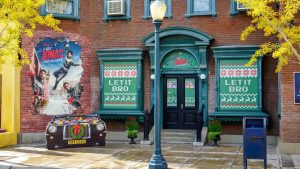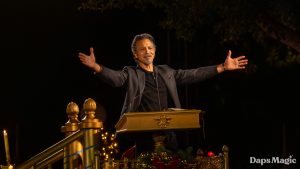Incredibly enough, the season finale of WandaVision is upon us. While it will be a relief to finally have the intricate plot lines pulled together (assuming they all are), it has been a lot of fun to speculate about them. It is not the intention of this article to explain it all, but rather to look at some of the interesting “secrets,” some of which have been hidden in plain sight. Please note, this article is loaded with spoilers for the first eight episodes. Stop right now if you are planning to binge watch the series for the first time.

We start with a lie, or what those who study film might call a false narrative. In episode four SWORD Director Tyler Hayward shared the shocking revelation that Wanda had actually broken into the SWORD facility and stolen Vision’s body.


The proof offered to the stunned investigators was a set of surveillance camera videos. Note that as Wanda moved through the facility, cameras selectively “blacked out” as they went offline. In reality, there is no footage depicting Wanda’s nefarious deed… because it never happened.

It was not until episode seven that viewers finally saw what actually did happen. Wanda did not storm the facility, nor did she spirit away the remains of Vision. She instead confronted the reality that he was not there, and departed bereft and confused.
This false narrative has been explained to the viewing audience… but not to the team surrounding Director Hayward. Even Wanda is unlikely to be aware that she stands accused of this monstrous crime.
Departing the SWORD facility empty-handed, Wanda makes her way north to a nondescript town in New Jersey. Westview is not an arbitrary choice, as we learn in episode eight.


Westview’s drab downtown business district in the real world stands in stark contrast to Wanda’s idealized sitcom version. All the elements are there, but how changed they are. Most notable is the town’s charming gazebo, boarded up behind construction fencing.


Wanda’s powerful makeover alters Westview not into its actual former appearance, but rather into an idealized place that also represents Wanda’s state-of-mind. This is evidenced by the prominent placement of an advertising sign for “Lagos” paper towels. The “mess” in Lagos figures prominently in Wanda’s past.
One interesting detail did slip by the production designers. The Wentworth Department Store is the fairly prominent structure on the left, facing the gazebo. In both the real-world and idealized view, the upper floors are covered with a honeycomb pattern steel facade. But that facade is missing in the views seen as the town is transformed. There is a technical term for this in the film and television industry. It is called a mistake.

If there were any doubts, here is a closer view of Wentworth’s, as seen during the talent show in episode two.
The cast of Wanda’s idealized world is drawn from the actual citizens of Westview. In episode four many of them are identified, with a couple of vivid exceptions. In episode eight the viewing audience gets to see a few of them in the real Westview.


A nondescript man making his way from Westview Appliance to the library turns up later as affable neighbor Herb.


This woman nursing a solo cup of coffee at a sidewalk cafe turns up as the elegant Mrs. Hart in episode one’s memorable dinner party scene.




The pizza delivery man got the choice role of the town mailman, turning up in episode one (the 1950s), episode five (the 1980s) and episode seven (the 2000s)


And then there is the citizen who is cast as the hapless Phil Jones. In the real world he is seen posting a notice offering piano lessons, on the construction wall surrounding the gazebo. Viewers know he is an accomplished player, as he is seen performing during the town talent show in episode two.



There’s a funny thing about that talent show. While we can hear a lively piano version of “Speed Polka” accompanying the dancers (whether in vaudeville garb or western costume), there is no one at the piano. It is only when the camera moves in for a closeup that we actually see Phil.



We know that Phil is nothing if not dedicated to the piano. When Vision picks it up single-handed and Wanda turns it into a flattened prop, the crowd is first mystified then delighted. Only Phil is alarmed, muttering, “That was my grandmother’s piano.”

We do not see the real-world counterpart for Dottie, Phil’s wife, and the “Queen Bee” of episode two. She is briefly glimpsed, hovering over her prize roses, in episode seven.

The first business viewers see when Wanda drives into downtown is Westview Appliances. It looks like it has seen better days, but then, isn’t that true of the whole town?


Wanda’s hex leaves the name and location intact, but the “sitcom” version now features a window full of television sets. There’s even a prominent advertisement for color TV. Clearly, this is significant to the girl from Sokovia.
Some sharp-eyed viewers of WandaVision may have noted just how important Westview Appliances and it’s alluring window full of televisions really is. The business has made a number of surreptitious appearances throughout the season. The back page of every edition of the Westview Herald newspaper carries a prominent display ad for Westview Appliances.

Here it is in episode one, shown straight to the camera by Vision shortly after his first entrance.

In case you missed it, the calendar on the wall is also an advertisement for Westview Appliances. The text below the picture reads: “All this little girl needs is a color television.”

In episode three, it is Phil who holds the paper, while the Westview Appliances ad reads:
“We have all the latest models at the best prices.”

In episode five the store is not only offering television sets, but your choice of VHS or BETA video players. “Westview Appliances: Embracing the new technology!”

It’s a bit harder to read the back of the Westview Herald in the faux-video opening of episode six. Since it is set in the 90s, it appears the Westview Appliances is promoting gaming systems.
This is not the only business that gets a multi-decades makeover. The Coronet Theater also benefits from some Wanda hex.



The real world Coronet appears to be a run down concert venue. Tannhauser Gate is an arcane reference to Blade Runner, a highly influential movie in the realm of dystopian science fiction. The double feature in the hex version is a slightly false note, as Kidnapped was released in 1960 and Big Red in 1962. Both are Disney releases, however. And read together one might interpret it to be saying, “Big Red kidnapped.” (Note also that Vision’s inner works were literally “gummed up” when he accidentally swallowed a stick of Big Red in episode two.) By episode six the Coronet has been “twinned,” offering a Disney movie in each auditorium.


One of the grimmer sights in the real Westview is the fetid community pool. It is also alarming that the town is inviting a major lawsuit by not keeping this hazard safely enclosed. Wanda’s version features sparkling water, attentive pool boys, and a complete enclosure.

As Wanda makes the final turn onto “her” street, there is a house largely shielded by trees that will feature prominently in the rest of episode eight. It is also one of the most iconic houses on the Warner Ranch Lot where much of the series was filmed.

The house was purposely obscured in early episodes. Here, in episode two, only a pair of dormer windows can be seen peeking over the neighbor’s trees.

Most viewers probably did not realize the animated opening of episode two featured a stylized version of the house, and linked it conclusively to nosy neighbor Agnes.

In episode five, viewers were treated to an oblique view of the house, and Agnes’ azalea bushes that we were told were fatal to Billy and Tommy’s dog, Sparky.

Late in episode seven the house was almost fully revealed. This angle may have also been carefully chosen to illustrate how Agnes could keep an eye on her neighbors from inside the house.


The nosy neighbor was a staple of television sitcoms, and none played better than Gladys Kravitz from Bewitched. Her classic pose found her peering through the drapes at the suspected witch next door. The difference in WandaVision, of course, is that Agnes IS the witch next door: Agatha Harkness.


It is only after Wanda’s journey through her own past that the viewing audience is finally treated to a full view of the home of Agnes/Agatha. It is the actual backlot set that was the home of Samantha Stevens, television’s most famous witch, for the entire run of the classic sitcom Bewitched.
As the camera follows Wanda down the sidewalk and into the street, we see that the azalea bushes, like so much of Westview, were merely an illusion. Agatha really did kill Sparky.

Did the house exist in Westview before Wanda’s hex? Was it her creation? Or was it a sort of “gingerbread house” conjured up by Agatha Harkness to appeal to the little girl from Sokovia? Any explanation fits the narrative; we know it was familiar to Wanda, based on the contents of her father’s satchel.
Not found in any of those cheery situation comedies was the forbidding chamber in Agatha’s basement. There was, however, something oddly familiar about it for fans of the MCU.


That octagonal chamber, ringed by arches, is evocative of the ruined church found at the center of Sokovia, and pivotal to the plot of Avengers: Age of Ultron. This is the entry in the series that introduced both Wanda and Vision to the MCU. Of further note, this is the last place where Wanda saw her twin brother Pietro alive.


It is also the location where Wanda displayed the first hint of the immense power she could wield when sufficiently provoked.

Before the full reveal of Agnes/Agatha’s house, episode eight gave us an important piece of the WandaVision puzzle: Why Westview? As Wanda pulled into the driveway next to a familiar house (with a pair of equally familiar dormer windows at the end of the street), an oddly jarring object appeared in the foreground. Instead of Wanda’s neat and tidy middle-American front yard, it is the neglected foundation of an unbuilt house.


The full reveal is one of the more poignant moments in WandaVision. In place of Wanda’s dream home we see a weedy lot and construction rubbish. Lest there be any doubt, a reverse shot reveals the familiar house across the street, albeit in its shabby, real world appearance.

A lingering shot of a Property Deed in Wanda’s hands fills in some important details. The address and location are revealed, along with a sweet note, ostensibly from Vision himself: “To grow old in.”
There are a couple of slightly puzzling details in the document. The street, Sherwood Drive, is depicted as a fairly tight curve, with a sidewalk that is set well back from the curb. The footprint of the Vision home is also different, with an indication of a bay window to the left of the front door.

A high and wide shot of Wanda in the center of the foundation is a fairly realistic depiction of the size and scale of the Vision home.

In episode 5 viewers could also spot the Sherwood Drive street sign at the other end of the street.

On a slightly more amusing note. A wider side view of the Vision property reveals a shortcoming of backlot neighborhoods. Dottie’s expansive house next door, it turns out, is only one room deep!

If that sweet little heart on the Property Deed looked kind of familiar, there’s a good reason. Hearts have turned up in other episodes.

Here is the heart, marking a calendar date, that set off the wacky confusion of Vision and Wanda’s first dinner party in episode one.

In the program opening from episode seven there is another calendar and another heart (though no explanation).

The grandest heart is the one that Vision “draws” in the sky in the animated opening of episode two. So it is only fitting that this article end on that hopeful note, with a symbol of the love shared between the funny, lovely, magical Wanda and her dashing Vision.
Oh!
But about that circus out on the edge of town!

The one that magically appeared (literally) at the end of episode six.

Viewers of WandaVision know full well that it is actually the hexed SWORD base, last seen in its original form as Wanda expanded the boundary of her idealized Westview.

Not aware of this are the personnel of SWORD, including Dr. Darcy Lewis, who had just been handcuffed to a vehicle by her military escort.

So it only makes sense (to viewers, at least) that Darcy is seen inside the hex as a strong and capable professional Escape Artist.


Her tormentor, on the other hand, does not fare as well in the hex. He does, however, get a very fancy costume, emblazoned with a big, gold “S.” Could that stand for the name of the circus?

There is a distinctive logo associated with the company. It can be seen on the small banner attached to the Big Top, as well as emblazoned on the doors of the dark green clown car. Regrettably, they are too far away to make out any text.


Closeup views are also hard to come by. The clowns keep blocking the car doors (So. Many. Clowns.), and an elaborate feathered headdress obscures the banner on the tent.

It is only as Darcy walks away that we get a clear view of the door.

A closer look reveals an elephant, whose trunk appears to be a stylized “S,” and a semi-circle of text above. It is not a name, but a promise of what this circus will deliver: Spectacular World Of Rapturous Diversions. If that’s too much to remember, just use an acronym.






